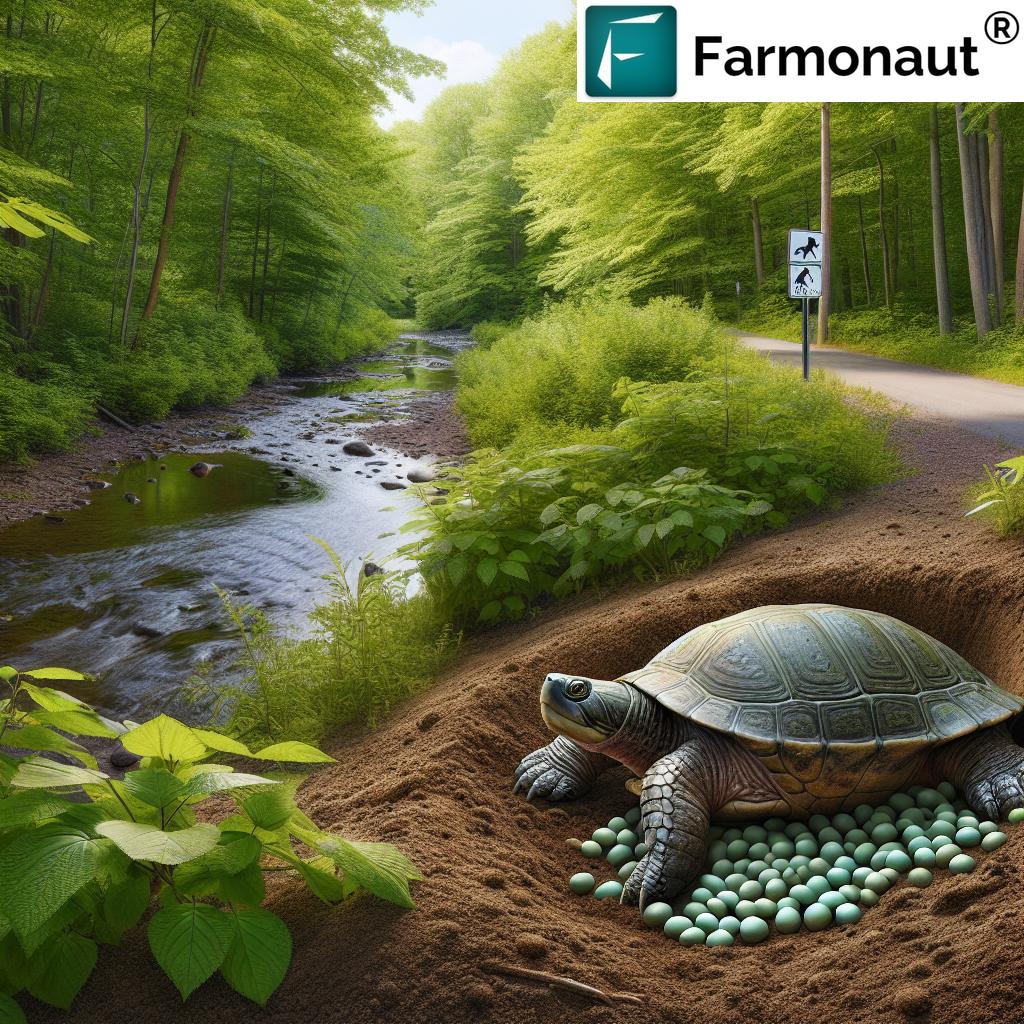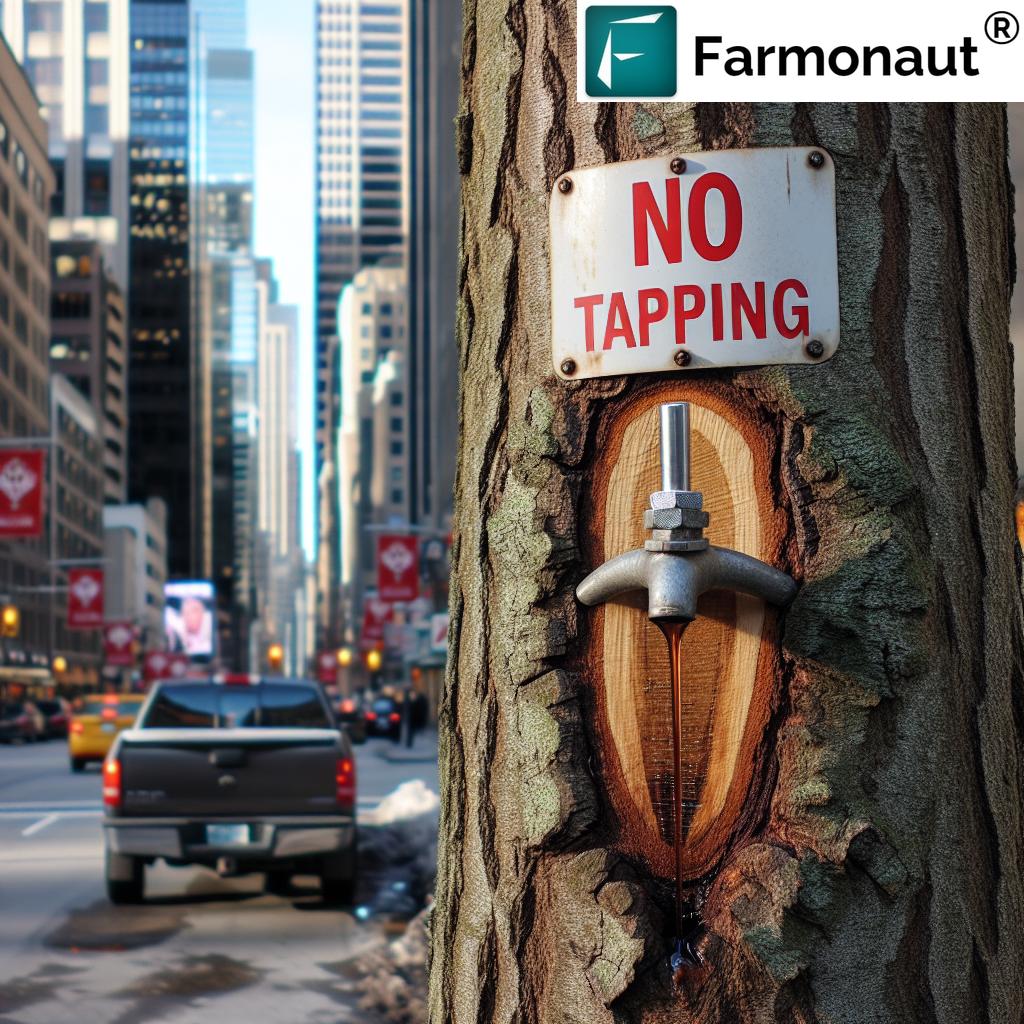Turtle Nesting Season Connecticut: 7 Powerful Ways to Protect Eggs
Meta Description: Turtle nesting season Connecticut brings female turtles crossing Hartford roads and laying eggs near waterways. Discover vital ways to protect nests, prevent road injuries, and support conservation in rural and wooded areas.
Table of Contents
- Introduction: Turtle Nesting Season Connecticut
- Turtle Trivia #1
- Understanding Turtle Nesting Season Near Hartford
- Female Turtles Nesting Habits and Nesting Sites
- Connecticut Turtle Nesting Facts & Protection Tips (Table)
- 7 Powerful Ways to Protect Turtle Eggs in Connecticut
- Turtle Trivia #2
- Protecting Turtles on Roads & Identifying Turtle Crossing Signs
- Injured Turtles: What to Do & Rehabilitating Turtles Guidelines
- Sustainable Farmland Management & Turtle Conservation with Farmonaut
- Frequently Asked Questions about Turtle Nesting Season Connecticut
- Farmonaut Affordable Subscriptions
- Conclusion: Ensuring a Bright Future for Connecticut’s Turtles
Introduction: Turtle Nesting Season Connecticut
Every year as spring shifts to summer, we in Connecticut witness an extraordinary event—turtle nesting season. Along the banks of waterways, through rural and wooded landscapes, and even on the roads outside Hartford, Connecticut’s turtles emerge for the most important phase of their lives. Understanding this annual cycle and discovering the 7 powerful ways to protect eggs can help ensure the survival of these remarkable reptiles for generations to come.
Understanding Turtle Nesting Season near Hartford, Connecticut
Turtle nesting season Connecticut is a highlight of our state’s natural calendar—a time when female turtles leave their aquatic habitats to seek ideal egg-laying spots. Connecticut’s diverse landscapes, from rural and wooded terrain to suburban backyards, become bustling thoroughfares for turtles seeking loose soil and proximity to waterways. During this season, it’s common to spot turtles laying eggs near Hartford or venturing across roads, especially during warm, sunny mornings or late afternoons.
Female Turtles Nesting Habits: The Journey to Lay Eggs
Understanding female turtles nesting habits is key to effective conservation. Female turtles in Connecticut often travel surprising distances to find suitable nesting sites. These sites are usually in areas with:
- Loose, sandy, or soft soil that’s easy to dig into
- Locations close to water (ponds, lakes, streams, marshes, and rivers)
- Low vegetation cover to provide sun warmth for egg incubation
- Minimal predation risk, although many nests are still vulnerable
The nesting process involves the female turtle using her hind legs to dig a small cavity in the soil. She then deposits a clutch—anywhere from a handful to dozens of eggs—before carefully refilling the nest and disguising it from predators.
Because natural nesting sites are often near busy roads or in human-altered landscapes, Connecticut turtles face growing challenges during the nesting season. Habitat fragmentation, road mortality, and increasing numbers of predators all threaten the survival of the next generation.
Connecticut Turtle Nesting Facts & Protection Tips
To better understand turtle conservation Connecticut, let’s look at a summary of common turtle species near Hartford, their nesting periods, typical locations, main threats, and practical protection actions.
| Species Name | Nesting Period (Estimated Months) |
Typical Nesting Locations | Main Threats | Recommended Protection Actions |
|---|---|---|---|---|
| Eastern Painted Turtle | June–July | Open sandy/loose soil near ponds & lakes, roadsides | Road mortality, predators (raccoons, skunks), habitat loss | Watch for turtles on roads, support nest protection, promote safe crossings |
| Snapping Turtle | Late May–July | Gravelly soil, riverbanks, canal edges, lawns | Traffic, nest predation, urban sprawl | Install turtle crossing signs rural areas, avoid disturbing nests |
| Eastern Box Turtle | May–July | Deciduous wooded edges, meadows, gardens | Habitat loss, fragmentation, collection, roads | Preserve wooded/edge habitats, monitor for nests |
| Spotted Turtle | May–June | Marsh edges, swampy fields, wet grassland | Habitat draining, predators, traffic | Restore wetland buffers, monitor nests, support marsh preservation |
| Wood Turtle | June | Riverbanks, sandy floodplains, rural wooded settings | Agricultural runoff, nest poaching, vehicle strikes | Encourage eco-friendly farming, install road signage, avoid mowing during nesting |
7 Powerful Ways to Protect Turtle Eggs During Nesting Season in Connecticut
When it comes to turtle nesting season Connecticut, every one of us in the community can make a positive difference for turtles laying eggs Hartford and surrounding areas. Here are the top seven actionable strategies for protecting turtle eggs, supporting ecosystem health, and fostering sustainable environments in our state.
1. Watch Out for Turtles Crossing Roads—Protecting Turtles on Roads
Spring and summer mornings often see turtles crossing roads near Hartford and along rural routes. They may be on their way to or from nesting sites. Road mortality is the leading cause of adult turtle deaths during nesting season.
- Slow down in posted areas, especially where you see turtle crossing signs rural areas.
- Alert others if a turtle is spotted, and give them ample space.
- Only move a turtle if it is in immediate danger—always move it across the road in the same direction it was headed, not back to where it started.
- Avoid moving turtles to new areas; their survival depends on familiarity with local habitat.
2. Preserve and Restore Nesting Habitats
Sustainable land management is crucial for the survival of turtles laying eggs Hartford. Supporting open, loose soil areas near waterways offers suitable sites for laying eggs.
- Keep grassy, wooded, or sandy patches undisturbed, especially from May to July.
- If you own land near wetlands or waterways, consider setting aside a portion for wildlife.
- Mow lawns more carefully and avoid mowing suspected nesting areas during nesting season.
- Restore natural vegetation along streams and pond banks.
Such efforts are aligned with modern sustainability goals. Solutions like Farmonaut’s Carbon Footprinting platform help track and minimize environmental impact, promoting biodiversity alongside agricultural productivity.
3. Mark and Monitor Known Nesting Sites
Protecting turtle eggs in Connecticut involves keeping track of traditional nesting grounds.
- Mark nest locations with discreet, non-intrusive markers so activities like mowing or construction can avoid disturbing eggs.
- Avoid placing objects directly on top of nests (which could block hatchlings’ emergence).
- Engage with local conservation groups to help monitor nest activity.
- Report rare or unusual nesting to local wildlife authorities so they can assess for extra protection.
4. Install Predator Exclusion Devices (Nest Protectors)
Each year, up to 90% of turtle eggs in Connecticut are lost to predators or unintentional destruction. Simple nest exclosures, such as wire mesh frames pinned over the nest, can deter raccoons, skunks, and foxes.
- Use lightweight, quarter-inch wire mesh cut to a square about 40 cm per side.
- Secure the mesh with stones or landscape pins so it can’t be lifted easily but will not trap hatchlings on their emergence.
- If in a public area, clearly label protection devices to educate passers-by and reduce tampering.
5. Educate the Community and Support Turtle Awareness Campaigns
Community-level conservation has lasting positive effects on turtle populations. We can:
- Share facts about turtle nesting season Connecticut and local nest protection tips on social media and neighborhood newsletters.
- Encourage schools in and around Hartford to include local wildlife conservation in their science or sustainability curriculum.
- Request that local authorities install more turtle crossing signs rural areas during peak nesting months.
6. Practice Responsible Pet Ownership in Rural and Wooded Areas
Predation from domestic animals, particularly unleashed dogs and outdoor cats, puts nesting turtles and eggs at high risk.
- Keep dogs and cats indoors or leashed, especially near known nesting sites in the season.
- If walking a dog near a waterway, use a short leash and keep an eye out for turtles moving on land.
- Discourage children from handling or disturbing turtles found in nesting areas.
7. Engage in Sustainable Resource Management
As land stewards, we share a responsibility to balance socio-economic interests with ecosystem health. Technologies like Farmonaut’s advanced satellite monitoring tools allow responsible management of farmland adjacent to turtles near waterways while also supporting habitat requirements.
- Use real-time environmental monitoring to minimize soil disruption during peak turtle activities. Discover Farmonaut’s large-scale farm management platform for actionable insights on sustainable land practices.
- Encourage local agricultural businesses to implement blockchain-based traceability solutions ensuring wildlife-friendly operations— tracing the environmental impact from seed to plate.
- Explore Farmonaut’s crop loan and insurance verification solutions for eco-sensitive coverage, incentivizing turtle-friendly farming near nesting habitats.
- Access advisory tools to manage fleet operations with minimal wildlife interference during sensitive months.
Protecting Turtles on Roads & Turtle Crossing Signs in Rural Areas
Many people ask why turtles crossing roads is such a problem in Connecticut. The reason is simple: most aquatic and semi-aquatic turtles have to travel from their home in the water to find suitably open ground for nesting, often crossing dangerous rural and suburban roads in the process. During turtle nesting season Connecticut, we see spikes in turtle encounters on highways and byways near Hartford and throughout the state.
What to Do When You See a Turtle on the Road
- If you spot a turtle, slow down and safely pull over if needed.
- Check for approaching cars and ensure it is safe before stepping onto the road.
- Always move the turtle in the direction it is facing—don’t turn it around or relocate it far away, as it will try to cross again.
- For snapping turtles, use a stick or shovel to gently nudge the back—never lift by the tail.
- If injured, note its location and contact local wildlife authorities for guidance (see “injured turtle what to do” below).
Why Rural and Wooded Areas Are Risk Zones for Turtles
Rural roads often bisect key habitats: wetlands, forest edges, and farmlands—all favorite nesting grounds. Connecticut DOT in recent years has installed more turtle crossing signs rural areas to alert drivers and encourage wildlife-friendly driving during peak months.
If you own or manage property in townships near Hartford—especially those close to schools, parks, or waterways—petition your municipality for additional signage and community education programs.
Injured Turtle What to Do — Rehabilitating Turtles Guidelines
While our instinct may be to help, it is essential to follow best practices and state guidelines for handling injured or distressed turtles. Connecticut’s Department of Energy and Environmental Protection (DEEP) offers clear instructions:
What to Do If You Find an Injured Turtle
- Do not attempt to treat, keep, or feed an injured turtle yourself.
- Carefully move the turtle to a safe place off the road if it’s at risk of further harm.
- Note the exact location for potential release after rehabilitation.
- Immediately contact DEEP Wildlife Division, a licensed wildlife rehabilitator, or a local animal rescue center.
- Handle the turtle as little as possible; minimize additional stress and risk of infection.
Proper rehabilitating turtles guidelines are crucial because wild turtles have complex medical and ecological needs. Attempting to care for one at home—even with good intentions—can result in unintentional harm and is often illegal under state law.
Why We Shouldn’t Keep Wild Turtles as Pets
Removing turtles from the wild, especially during nesting season, can disrupt local populations and reduce reproductive success. Connecticut law strictly limits handling and possession of native turtles for these reasons.
Sustainable Farmland Management Meets Turtle Conservation Connecticut
Sustainability is not only about improving crop yields or reducing chemical use; it is just as much about creating harmony between agriculture and local wildlife, especially during turtle nesting season Connecticut.
Farmonaut is committed to affordable, accessible, and environmentally savvy farm management powered by cutting-edge satellite technology, artificial intelligence, and actionable data insights. Here’s how Farmonaut can play a critical supporting role in turtle conservation Connecticut and overall environmental stewardship:
- Real-Time Crop & Soil Health Monitoring: By leveraging satellite imagery, Farmonaut provides farmers actionable information about soil health, water usage, and vegetation cover. Maintaining diverse, low-impact field margins is a powerful way to support turtles near waterways and their nesting grounds.
- AI Advisory for Wildlife-Friendly Practices: Farmonaut’s Jeevn AI can advise on optimal times for land preparation and irrigation, helping landowners reduce disruptions during key turtle nesting months.
- Carbon Footprint Tracking: With Farmonaut’s carbon footprint monitoring, farmers and agribusinesses can benchmark and actively lower their environmental impact, which supports greater biodiversity in rural and wooded areas.
- Blockchain-Based Traceability: Traceability solutions foster consumer trust in “wildlife-friendly” farm products, motivating broader conservation practices at scale.
- Resource & Fleet Management: Farmonaut’s fleet and resource management tools enable responsible scheduling, so machinery avoids sensitive soil areas during nesting season.
- Support for Forest Edges & Plantation Buffer Zones: By integrating Farmonaut’s forest advisory features, users are empowered to design land use that sustains both crops and native turtle populations.
Our collective efforts—whether as farmers, landowners, educators, or wildlife enthusiasts—can be amplified through platforms and technologies designed for sustainability. Farmonaut supports ecosystem health while providing actionable insights, so everyone can actively participate in the protection of turtles laying eggs Hartford and across Connecticut.
Frequently Asked Questions: Turtle Nesting Season Connecticut
When is turtle nesting season in Connecticut?
Turtle nesting season Connecticut generally peaks from May through July. However, some species, such as the spotted turtle, may begin earlier, and others like the snapping turtle may nest into late July.
Where do turtles lay eggs near Hartford?
Turtles laying eggs Hartford prefer loose or sandy soil close to waterways—ponds, rivers, marshes, and lakes. Many urban and rural areas near Hartford also host nests along lawns, gardens, and even roadside banks.
How do I know if a turtle nest is active?
Signs of active nests include small, recently disturbed patches of soil, often in sunny open locations. It’s best not to disturb these areas—monitor from a distance or report to local wildlife organizations.
How can I help if I see a turtle crossing the road?
Move the turtle in the direction it was heading, only if it is safe and necessary. For snapping turtles, use tools like a stick to gently push from behind. Never turn a turtle around or take it to a new location.
What should I do with an injured turtle?
You should not attempt to rehabilitate an injured turtle yourself. Instead, move it to safety if possible and contact licensed wildlife rehabilitators or the Connecticut DEEP for professional help.
Should I put up turtle crossing signs?
If your property or local roadside is in a high-traffic turtle area, petition your local authorities for signs. Community engagement can help secure official warning signs in rural and wooded areas.
Farmonaut Affordable Subscriptions
Conclusion: Ensuring a Bright Future for Connecticut’s Turtles
Turtle nesting season in Connecticut is both a natural wonder and a critical opportunity for action. By learning about Connecticut’s turtles—whether you’re keeping watch for turtle crossing signs in rural areas, helping protect nests, or adopting eco-friendly farming practices—we all play a role in turtle conservation Connecticut.
With the right knowledge, community spirit, and innovative technology like Farmonaut, we can rise to the challenge and ensure our state’s turtles thrive for generations. Let’s keep our roads safe, our soil healthy, and our waterways pristine—because every nest and every egg is a step toward a more sustainable and vibrant Connecticut.


















